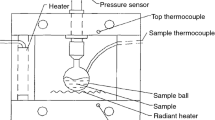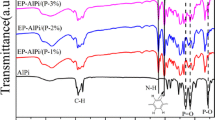Abstract
A new model of iodine-Epoxy paint interaction under irradiation has been developed with new relevant data to better reproduce and predict how much iodine could be released in the environment in case of a severe accident in a Pressurized Water Reactor. Its application to the modelling of volatile iodine behaviour in PHEBUS-FPT-3 test is presented and shows that other phenomena might govern the iodine volatility in the mid and long term. A broader analysis of the gaseous iodine behaviour is finally presented, highlighting the need to identify and model new gaseous chemical reactions that might play a significant role on iodine volatility.











Similar content being viewed by others
References
Hanniet-Girault N, Repetto G (1999) FPT-0 Final Report. IPSN report PH-PF IP/99/423
Jacquemain D, Bourdon D, De Bremaecker A, Barrachin M (2000) FPT-1 Final Report. IRSN report PH-PF IP/00/479
Grégoire AC, March P, Payot F, Ritter R, Zabiego M, De Bremaecker A, Biard B, Gregoire G, Schlutig S (2008) FPT-2 Final Report. IRSN report DPAM/DIR-2008-272, PHEBUS PF IP/08/579
Payot F, Haste T, Biard B, Bot-Robin F, Devoy J, Garnier Y, Guillot J, Manenc C, March P (2011) FPT-3 final report. IRSN Document PHEBUS PF IP/10/587
Schwarz M, Hache G, Von Der Hardt P (1999) PHEBUS FP: a severe accident research programme for current and advanced light water reactors. Nucl Eng Des 187:47–69
Girault N, Dickinson S, Funke F, Auvinen A, Krausmann E (2006) Iodine behaviour under LWR accident conditions: lessons learnt from analyses of the first two Phebus FP tests. Nucl Eng Des 236(12):1293–1308
Girault N, Bosland L, Dickinson S, Funke F, Güntay S, Herranz L, Powers D (2012) LWR severe accident simulation: iodine behaviour in FPT-2 experiment and advances on containment iodine chemistry. Nucl Eng Des 243:371–392
Clément B, Hanniet-Girault N, Repetto G, Jacquemain D, Jones A, Kissane M, Von Der Hardt P (2013) LWR severe accident simulation: synthesis of the results and interpretation of the first Phebus FP experiment FPT-0. Nucl Eng Des 226(1):5–82
Birchley J, Haste T, Bruchertseifer H, Cripps R, Güntay S, Jäckel B (2005) Phebus-FP: results and significance for plant safety in Switzerland. Nucl Eng Des 235(15):1607–1633
March P, Biard B, Manenc C, Payot F, Gaillard C, Guillot J, Morassano B, Pepino M, Simondi-Teisseire B, Gamier Y, Gregoire AC, Masson V, Pantera L (2006) First results of the PHEBUS FPT-3 test. In: 14th international conference on nuclear engineering, Miami, Florida, USA
Bosland L, Funke F, Girault N, Langrock G (2008) PARIS project: radiolytic oxidation of molecular iodine in containment during a nuclear reactor severe accident. Part 1. Formation and destruction of air radiolysis products-Experimental results and modelling. Nucl Eng Des 238(12):3542–3550
Bosland L, Funke F, Girault N, Langrock G (2011) PARIS project: radiolytic oxidation of molecular iodine in containment during a nuclear reactor severe accident: Part 2: formation and destruction of iodine oxides compounds under irradiation—experimental results modelling. Nucl Eng Des 241(9):4026–4044
Dickinson S, Auvinen A, Ammar Y, Bosland L, Clement B, Funke F, Glowa G, Karkela T, Powers D, Reeks M, Tietze S, Weber G, Zhang S (2014) Experimental and modelling studies of iodine oxide formation and aerosol behaviour relevant to nuclear reactor accidents. Anal Nucl Energy 74:200–207
Dickinson S, Girault N, Herranz L (2007) Interpretation of containment chemistry results from PHEBUS test FPT-2. In: Proceedings of the European Review Meeting on Severe Accidents Research, Karlsruhe, Germany
Dickinson S, Andreo F, Karkela T, Ball J, Bosland L, Cantrel L, Funke F, Girault N, Holm J, Guilbert S, Herranz L, Housiadas C, Ducros G, Mun C, Sabroux JC, Weber G (2010) Recent advances on containment iodine chemistry. Prog Nucl Energy 52(1):128–135
Dickinson S (1998) Iodine Chemistry Project—Final Report. Commission of the European Communities—Fourth Framework Programme on Nuclear Fission Safety—FI4S-CT95-0005—ST-IC/P(98)21 Issue 2
Dickinson S, Baston G.M.N, Sims HE, Funke F, Cripps R, Bruchertseifer H, Jäckel B, Güntay S, Glannëskog H, Liljenzin J.O, Cantrel L, Kissane M, Krausmann E, Rydl A (2003) Iodine chemistry and mitigation mechanisms: ICHEMM final synthesis report. EC, 5th Euratom Framework Programme 1998-2002, FIKS-CT1999-00008
Cantrel L, Cousin F, Bosland L, Chevalier-Jabet K, Marchetto C (2014) ASTECV2 severe accident integral code: fission product modelling and validation. Nucl Eng Des 272:195–206
Van Dorsselaere JP, Chatelard P, Cranga M, Guillard G, Tregoures N, Bosland L, Brillant G, Girault N, Bentaib A, Reinke N, Luther W (2010) Validation status of the ASTEC integral code for severe accident simulation. Nucl Tech 170(3):397–415
Bosland L, Cantrel L, Girault N, Clément B (2010) Modelling of iodine radiochemistry in the ASTEC severe accident code: description and application to FPT-2 PHEBUS test. Nucl Technol 171(1):88–107
Chatelard P, Reinke N, Arndt S, Belon S, Cantrel L, Carenini L, Chevalier-Jabet K, Cousin F, Eckel F, Marchetto C, Mun C, Piar L (2014) ASTEC V2 severe accident integral code main features, current V2.0 modelling status, perspectives. Nucl Eng Des 272:119–135
Guilbert S, Bosland L, Fillet S, Jacquemain D, Andreo F, Ducros G, Dickinson S, Herranz L, Ball J (2008) Formation of organic iodide in the containment in case of a severe accident. Transactions of the American Nuclear Society, Annual Meeting, June, 08-12 Anaheim, United States, vol 98, pp 291–292
Aleksandrov AB, Ampelogova NI, Karaseva MA, Kritskii VG, Petrik NG (1995) The effect of physicochemical conditions on the absorption of molecular iodine by protective varnish and paint coatings during accidents at a nuclear power station with a VVER-640 reactor. Therm Eng 42(12):991–996
Zoulalian A, Belval-Haltier E (1998) Interaction between molecular iodine in gaseous phase and a coat of paint—influence of temperature, humidity, and hydrothermal treatment on iodine trapping kinetics. Nucl Technol 122:196–210
Belval-Haltier E, Taylor P (1999) Iodine volatile species production from painted surfaces of a reactor containment during a severe accident. OECD Workshop on iodine aspects of severe accident management, Vantaa, Finland, May 18-20, pp 103–118
Zoulalian A, Belval-Haltier E (2000) Interaction between molecular iodine in a gas phase and paints aged in a nuclear power plant”. Nucl Technol 130:362–371
Nugraha T (2003) Interactions of I2 with paints under condensing steam conditions. Thesis—University of Toronto, Canada
Funke F (1999) Data analysis and modelling of organic iodide production at painted surfaces. OECD Workshop on Iodine aspects of severe accident management, Vantaa, Finland, May 18-20, pp 151–168
Marchand C (1997) Production d’iodures organiques à partir des surfaces peintes de l’enceinte de confinement d’un réacteur à eau pressurisée en situation accidentelle. Thesis—Université Paris XI, Orsay, France
Clément B, Simondi-Teisseire B (2010) STEM: an IRSN project on source term evaluation and mitigation, transactions of the american nuclear society—2010 ANS annual meeting and embedded topical meeting: isotopes for medicine and industry, Las Vegas, NV, United States, November 7-11th, vol 103, pp 475–476
Glänneskog H (2004) Interactions of I2 and CH3I with reactive metals under BWR severe-accident conditions. Nucl Eng Des 227:323–329
Evans GJ, Deir C, Ball J (1994) The retention of iodine in stainless steel sample lines. 23rd DOE/NRC nuclear air cleaning and treatment conference
Gupta S, Schmidt E, Von Laufenberg B, Freitag M, Poss G, Funke F, Weber G (2016) THAI test facility for experimental research o nhydrogen and fission product behaviour in light water reactor containments. Nucl Eng Des 294:183–201
Chojnacki E, Ounsy A (1996) Description of the IPSN method for the uncertainty and sensitivity analysis and the associated software: SUNSET. In: Proceedings of ASME/JSME ICONE, vol 3. Louisiana, USA, pp 545–550
Bosland L, Colombani J, Powers D, Dickinson S (2010) Towards a mechanistic interpretation of the iodine—paint interactions. ERMSAR, Bologna, Italia, May 11-12
Bosland L, Cantrel L, Clément B (2010) Iodine behavior in the primary circuit and on painted surfaces of a containment reactor: description of the modelling strategy. Transactions of the American Nuclear Society, annual meeting, November, 7th-11th, Las Vegas, United States, vol 103, pp 456–457
Colombani J, Chauvet E, Amat S, Dupuy N, Gigmes D (2017) A FTIR/chemometrics approach to charactrize the gamma radiation effects on iodine/epoxy-paint interactions in Nuclear Power Plants. Anal Chim Acta 960:53–62
Bosland L, Dickinson S, Glowa G, Herranz L, Kim HC, Powers D, Salay M, Tietze S (2014) Iodine-paint interactions during nuclear reactor severe accidents. Anal Nucl Energy 74:184–199
Maillo J, Pages P, Valleja E, Lacorte T, Gacen J (2005) FTIR spectroscopy study of the interaction between fibre of polyamide 6 and iodine. Eur Polym J 41:753–759
Rosenberg HS, Genco JM, Morrison DL (1969) Fission product deposition and its enhancement under reactor accident conditions: deposition on containment system surfaces. Report BMI-1865, Battelle Memorial Institute, Columbus, Ohio, United States
Hellmann S, Funke F, Greger G.U, Bleier A, Morell W (1996) The reaction between iodine and organic coatings under severe PWR accident conditions—an experimental study. In: Proceedings of the 4th CSNI workshop on the chemistry of iodine in reactor safety, EA/CSNI/R(96)6, June 10-12, Würenlingen, Switzerland, pp 345–364
Sims HE, Dickinson S, Evans G, Wren JC, Glowa G (1997) Iodine behaviour in containment: the reaction of iodine with surfaces. Report AEA Technology—ACEX TR-B-06
Dickinson S, Sims HE (2007) Network of excellence for a sustainable integration of European Research on severe accident phenomenology, Iodine Data Book Part 3: surface reactions. SARNET-ST-P48 Issue 1—Nexia Solutions (06)7042
Cantrel L, March P (2006) Mass transfer modelling with and without evaporation for iodine chemistry in the case of a severe accident. Nucl Technol 154(2):170–185
Glowa G, Moore CJ, Ball J (2013) The main outcomes of the OECD behaviour of iodine (BIP) project. Anal Nucl Energy 61:179–189
Cantrel L (2006) Radiochemistry of iodine: outcomes of the CAIMAN program. Nucl Technol 156:11–28
Chatelard P, Belon S, Bosland L, Carenini L, Chailan L, Coindreau O, Cousin F, Marchetto C, Nowack H, Piar L (2016) Main modelling features of ASTEC V2.1 major version. Anal Nucl Energy 93:83–93
Bosland L, Weber G, Klein-Hessling W, Girault N, Clément B (2012) Modeling and interpretation of iodine behavior in PHEBUS FPT-1 containment with ASTEC and COCOSYS codes. Nucl Technol 177(1):36–62
Mun C, Bosland L, Cantrel L, Colombani J, Leroy O, Ohnet M.N, Albiol T (2015) OECD/STEM project and its follow-up STEM2. In: Proceedings of the international OECD-NEA/NUGENIA-SARNET workshop on the progress in iodine behaviour for NPP Acc. Anal. and Manag.—March 30, April 1 - Marseille (France), Paper 1-10
Bosland L, Cantrel L (2015) Iodine behaviour in the circuit and containment: modeling improvements in the last decade and remaining uncertainties. In: Proceedings of the international OECD-NEA/NUGENIA-SARNET workshop on the progress in iodine behaviour for NPP Acc. Anal. and Manag.—March 30, April 1—Marseille (France), Paper 5-3
Stevens CM, Krout L (1972) Method for the determination of the concentration and of the carbon and oxygen isotopic composition of atmospheric carbon monoxide. Int J Mass Spectrom Ion Phys 8:265–275
Barnes RH, Mc Farling JL, Kircher JF, Townley CW (1968) Studies of methyl iodide formation under nuclear reactor accident conditions—Final report. BMI-1829, UNCL
Bartonicek B, Habersbergerova A (1986) Investigation of the formation possibilities of alkyl iodides in nuclear power plants. Radiat Phys Chem 28(5/6):591–600
Bartonicek B, Habersbergerova A (1987) Formation of methyl iodide by ionizing radiation. 4th working meeting on Radiation Interaction, Leipzig, pp 491–495
Acknowledgements
Authors acknowledge the OECD hosting the STEM project, the STEM partners for their support (Electricité De France, the Atomic Energy of Canada Limited, the Teknologian tutkimuskeskus VTT (Finland), Ústav Jaderného výzkumu Řež a.s (Czech Republic), The Gesellschaft für Anlagen—und Reaktorsicherheit (Germany), The Korea Atomic Energy Research Institute, The Korea Institute for Nuclear Safety and The US Nuclear Regulatory Commission) and the European Commission for having supported the ISTP project. Authors also acknowledge Jean BACCOU for his fruitful and kind contribution to the estimation of the uncertainties propagation with probabilistic tools and Karine CHEVALIER-JABET for her help in the estimation of the containment temperature evolution during a nuclear reactor accident. The acknowledgements are also addressed to the “EPICUR team” for its contribution to the experimental work.
Author information
Authors and Affiliations
Corresponding author
Rights and permissions
About this article
Cite this article
Bosland, L., Colombani, J. Study of iodine releases from epoxy and polyurethane paints under irradiation and development of a new model of iodine-Epoxy paint interactions for PHEBUS and PWR severe accident applications. J Radioanal Nucl Chem 314, 1121–1140 (2017). https://doi.org/10.1007/s10967-017-5458-9
Received:
Published:
Issue Date:
DOI: https://doi.org/10.1007/s10967-017-5458-9




